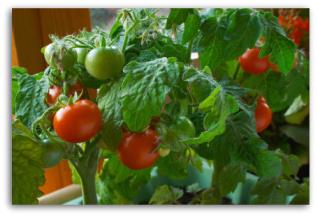Dry head and wet feet. The question is: who can withstand such torture? Only one whose fruits are nine-tenths of water. This is it, Signor Tomato. Do what you want, and provide the right amount of moisture, no more and no less.
Tomatoes that are quite demanding on soil and lighting require irrigation according to all the rules of agricultural science. And if their requirements are fully satisfied, they honestly respond to this with a significant increase in yield.
“Dry head” means that
air humidity should not exceed 50%. And “wet feet” - that soil moisture should not fall below 85%, but also not exceed the limit of 90%. On both sides of this gap, the tomato lurks problems. Waterlogging the soil will make the fruits watery, and the plant is vulnerable to fungal diseases. From drying out, it also gets sick, drops buds and ovaries.
Hence the answer to the question of how often you need to water tomatoes. Exactly following the conventional expression "rarely, but accurately".
"Rarely" is no more than one or two times a week. At the same time, it is plentiful enough, at the same time not filling them. Signor Tomato would not like to live “in a swamp” at all, because excessive watering is an increased
relative humidity, obviously not a “dry head”. The growth and development of the plant is significantly inhibited. The same will happen with frequent watering in small portions.
The exceptions are two periods: when the plant is immediately in the seedling stage immediately after planting, and when the fruits are massively tied. At this time, watering tomatoes like abundant, maintaining the soil in a state of high humidity. The rest of the time, it can be quite moderate. And so that the humidity is maintained at the proper level, do not forget about mulching.
Now about the "aptly." Water intended for watering a site with tomatoes should go under the root of the plants (but not with force, eroding the soil and exposing the root system) or along the furrows. At the same time, the soil is moistened without changing the air humidity. Drops of water should not remain on the leaves, stems and fruits of tomatoes. Each of them in the bright sun turns into a lens, leaving a burn after itself, wounds weaken the plant, and there it is not far from late blight ... Therefore, sprinkling in this case is not recommended. As you can see, it is not enough to determine how much water you need, you also need to know how to properly water the tomatoes.

By the way, they themselves will tell you if something goes wrong. If the plant receives insufficient moisture, its leaves will darken. In hot weather, they generally fade. In general, it should be said that watering tomatoes, depending on the age of the plants, their growth, planting patterns, soil moisture capacity, the presence or absence of a mulch layer, and climatic conditions, require unequal. Therefore, the volume of water will have to be determined experimentally.
Another important condition for success on tomato beds is water temperature. The ideal option is + 24-25 degrees. It’s also good if it is rainy, because it is soft. If this was not available, you can soften the available available natural means: compost or manure. For those who do not like to tinker with unpleasantly smelling substances, it is enough to load the results of the last weeding into the water set for settling, i.e. weeds.
In order for tomatoes to grow, bloom and ripen normally, watering must ensure that water is absorbed into the soil before it evaporates. If the weather is cloudy, you can water the plants at any time. A clear sunny day is expected - you will have to do it in the early morning or transfer it to the evening, two hours before the sun sets.
All of the above recommendations are given by gardeners who, year after year, receive excellent tomato crops from their beds. Why don't you join them?